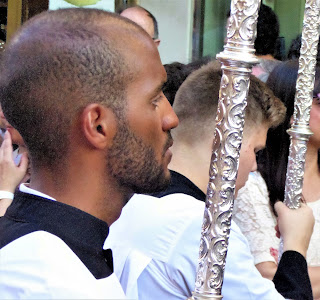Greetings
from Granada!
Being the guest of Charles and Linda offers the additional gift of being the guest blogger.
There’s no mistaking this week in Andalusia.
Being the guest of Charles and Linda offers the additional gift of being the guest blogger.
I’m Charles’ sister, here with my husband John, who’s convinced this Mediterranean seaside paradise bids our return.
To us, and to all who’ve visited, Charles and Linda are exceptional hosts, attentive personal tour guides, leading us to their favourite sights.
Yet this week, all four of us experienced a “first” together too.
It can be wrapped up in a name. She is called Granada, which means “pomegranate”.
She’s
a city that enchants, set against the snow-capped Sierra Nevada Mountains.
Her
name carries with it centuries of twists, turns and tales, yet her story hinges
on a single year, 1492.
While we associate this date with Christopher Columbus “discovering” the Americas in Spain’s name, .....
.....1492 also marks the end of an era for Europe – the
culmination of 700 years of Moorish rule … and Grenada was their final
stronghold …
.... this place, where even today, we see the genius and beauty in their
architecture and engineering achievements...
“Alhambra” in Arabic means “The Red One”, named for its red stone.

Their Christians conquerors admired it so much that they chose only to add to it, and adorn it with Christian symbols, rather than destroy it.
This is also true in other Granada neighbourhoods.
High on a mountain opposite the Alhambra is Plaza San Nicolas, ....
... where you’ll see ancient churches, ...
... originally built as mosques by
the Moors. Again, not destroyed, and still serving Christians today. The only difference on the outside is the cross standing on a peaked roof
And 1492 marks the year
Granada becomes a Christian city, leading us to the surprise.
Of all the weeks in a year, we are here during
Semana Santa - Holy Week, and what we’d heard is true....

..... that the best place in
Europe to see elaborate parades...
...... and celebrations during Easter is in Andalusia!
Don’t call it a parade.
It’s a “procesión”....
...... a procession signifying the enduring Christian faith.
Andalucía celebrates the
Week that Changed the World:
Each procession of Semana
Santa, Holy Week, tells the story of the days and events leading to the death
and resurrection of Jesus. While our first experience was totally serendipitous
in Granada, we’ve been thrilled since by processions in both Fuengirola and
Malaga.
In Malaga we almost felt like locals, waving to one of the revered
“pallbearers”, played by the landlord renting to Charles and Linda.
Some processions are
sombre, ....
.... even funeral-like .........
.....while others are joyous and up lifting.
You see, it all depends on the day and
story of Easter being
depicted.
These are extravagant shows. Hundreds participate, from
the very young, to the old. Each has a role.
The revered centrepieces of each
procession are called “thrones” or floats made of Stirling silver or gold, and weighing up to five and one half thousand kilograms ....
EACH ....
...... carried through a long, winding parade route for hours and hours by penitents, who....
..... often dressed in black, especially on days preceding and
on Good Friday; and in white on Easter Sunday.
You’ll see
women accompany the “thrones”, dressed in black with lace veils as for a
funeral, or....
..... in church gowns.
Ceremonial parade bands set the tone for the story
with their horns, woodwinds and beating drums.
In Granada, it was somewhat
of a shock at first....
....to see costumed “penitents” whose hoods, since copied by
the KKK in the United States, date to medieval times ….
.... when people robed themselves in long cloaks
and....
..... covered their heads with hoods fashioned with pointed cones allowing them
to clearly stand out and demonstrate their penance while masking their
identity.
It took time for me to see the shock turn to understanding, appreciating
their dedication marching ....
... or carrying the incredible burden of the twelve thousand pound throne under the heat of the Mediterranean sun (as high as 33 degrees), some blindfolded, others barely able
to see
 Granada, during Semana Santa, has offered us
sights unlike any we had ever seen. Goose-bump worthy scenes during processions, the expansive view at sunset from San Nicolás, and looking out across the valley to the Alhambra, which still stands guard just below the snowy Sierra Nevada Mountains.
Granada, during Semana Santa, has offered us
sights unlike any we had ever seen. Goose-bump worthy scenes during processions, the expansive view at sunset from San Nicolás, and looking out across the valley to the Alhambra, which still stands guard just below the snowy Sierra Nevada Mountains.
But one sight I hope
never to forget is Charles’ smile – unreserved ecstasy on his face from
exploring this city for the first time.
Charles is effusive in
his desire to learn and experience all he can, of the Spanish language, country
and history, its culture and people.
A newspaper ad this week describes him
perfectly:
“I want to live in Spain, but above all else, I want to live Spain.
Gracias Charles and
Linda. Thank you for your love and hospitality, and for sharing your Andalusia.
Thank you so much for your visit, Eleanor and John.
Thank you, too, Eleanor, for your wonderful writing.
To everyone who is following us, thank you for taking the time to read about our adventures in Spain. Next time, in our last blog, we'll take a look at "Fun-girola and those who helped make it a simply wonderful place to be.



































I'm so jealous to have missed such an incredible experience. Wonderfully captured, Eleanor :)
ReplyDelete